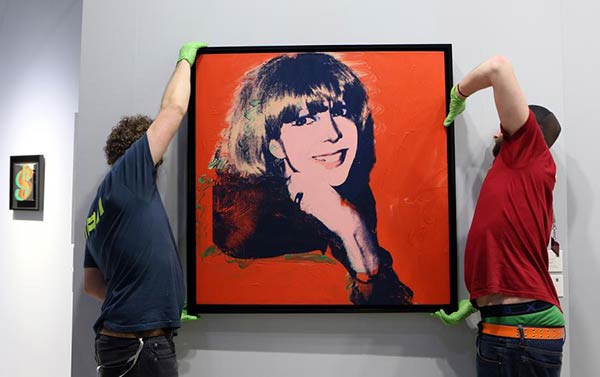
Staff members set up a creation of Andy Warhol at the Art Basel in Hong Kong, March 24, 2016. A total of 239 galleries from 35 countries and regions attended the 3-day Art Basel in Hong Kong this year. (Photo/Xinhua)
Wealthy Chinese are splashing big on foreign art pieces in recent years, marking a trend in art collecting becoming a major portion of their global assets.
During the just concluded Art Basel Hong Kong, many wealthy Chinese from the mainland nabbed contemporary pieces from all over the world with prices ranging from tens of thousands to millions of US dollars. This is a great cause of excitement for art galleries and artists, and David Zwirner Gallery from USA is already looking to locate a branch in Hong Kong, according to 21st Century Business Herald.
In recent years, Chinese moguls like Wang Jianlin, Wang Zhongjun and Liu Yiqian are splashing money in purchasing European art masters' works, including those by Pablo Picasso and Amedeo Modigliani, which has aroused the art world's attention.
The 21st Century Business Herald says that the scene makes people think of the time in the mid-80s when wealthy Japanese were pursuing masterpieces of the Impressionists. At that time, Japan's economy reached its peak with its cars and machines exported worldwide. The Japanese yen appreciated all of a sudden and lots of Japanese people went abroad and traveled overseas. Wealthy people and enterprises also splashed out abroad to purchase art pieces.
Today's China is quite like Japan at that time. But the problem is, after that, Japan's economy had been in recession due to the bursting of the asset bubble, and the art market broke too. Will China experience a similar situation, or avoid the decline?
Well, China is different from Japan in three main aspects. First, China has a much larger population which means a huge domestic market. Second, China has more a diversified and multi-leveled industrial system. Third, China has many resources and a powerful government which may save the dangerous situation caused by an asset bubble if it happens.
Against the unpredictable Chinese economy of the future, and the shrinking of the domestic art market, Chinese wealthy are still splashing big on art. Here are some of the reasons why.
First, wealthy Chinese's pattern of purchasing art overseas may be closely related to their asset allocation strategy worldwide. After the 1990s, the stepping up of globalization has made the global flow of capital and global asset allocation the wealthy's new strategy.
In recent years, many wealthy Chinese are buying real estate, opening or purchasing companies in Europe, USA, Canada, Australia, Singapore and others, while art is only a small portion of their assets.
However, many of these artworks are not taken back to China, and most are preserved in their real estate purchased overseas due to the consideration of spreading wealth to control risk, and the tariff as well. If the artworks enter into China legally, the gross tax will be more than 20% of the purchasing price, which is quite a large expense.
Second, purchasing European art masters' famous works is a status symbol financially and culturally. Millions spent on art will no doubt hit the headlines which causes a stir among media and the public, and the background of these individuals may also get exposed. On the other hand this is great publicity for their companies, including their branding, economic power and social image. Therefore, we can always see that when some wealthy Chinese buys a new art piece, it is announced to the public at once.
Third, the new rich in China buying European and American contemporary pieces also shows their effort in improving their taste in art, and their cultivation. They are trying to keep pace with the taste of global art collectors, usually led by European and American collectors, and are even trying to discover some meaningful pieces which are new creations from fresh artists ahead of them. This may exert a long term effect on the future domestic art market, as the more traditional styles of art may face a crisis, while hybrid Western-Chinese styles and more contemporary art gains a greater market.


















































